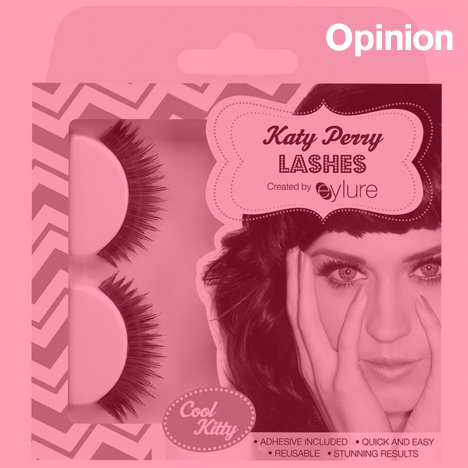
"We must examine the human cost of objects, not just their semiotic resonances"
Opinion: Kieran Long argues that while it's fun to be cynical about pop cultural artefacts like Katy Perry Lashes, a recent expose on the conditions in which they're made proves that it's vital for design criticism to move beyond semiotics.
I’ve always felt, in that completely unfair way we tend to judge big stars, that Katy Perry was the most cynical and dead inside of all the questionable female role models in the pop cultural landscape. The Popchips poster campaign she fronted earlier this year is burned into my retina. I saw her every morning at South Kensington Tube station, looking over the top of her sunglasses in a sarcastic gesture of astonishment at just how extraordinary a bag of crisps can be. Her fingernails were like talons and her steel grey eyes were framed in false eyelashes.
"All Katy Perry lashes by Eylure are handmade, 100% natural and each style is reusable," reads the description on the box of fake eyelashes that sits on my desk as I write. This comes just before "Katy’s top tips", the instructions, in the voice of the gazillion-selling pop star, about how to wear the lashes to their best effect.
There may be no more emblematic product of contemporary capitalism than Katy Perry Lashes, the false eyelashes endorsed by the megastar singer. They are made of real hair and the Cool Kitty style (one of three different designs available) of lash has an undulating profile, with longer and shorter hairs alternating and creating an effect that Katy Perry herself models in a photo on the front of the box.
Perry has a self-consciously plasticky, robot-from-the-1950s aesthetic that is always accessorised with false lashes, nail varnish and a comicbook hairdo. With this Stepford/Bladerunner thing, she seems to invite identification. Something about her plain, cybergirl-next-door look makes young women feel that they somehow should be her, or be like her. It’s no coincidence that most of her merchandise is products for the body: perfumes (a whole range of them), body lotion, makeup. By buying these objects, you are somehow transforming your physical substance into Perry’s. The lashes allow young people to get inside Perry’s body, to look out at the world through her eyes. This out-of-body experience is available for the reasonable price of £5.95 in high street pharmacies.
When her partnership with Covergirl cosmetics was announced, Perry was quoted as saying: "In addition to music, I've always considered makeup to be a powerful creative avenue of self-expression." In Perry’s world, you have to design yourself, to draw a new you on your own skin: she’s the perfect articulation of how contemporary pop culture raises narcissism to an art form.
In the end, this is the psychological game for which the fake eyelashes are designed as a prop. In themselves they may not seem like interesting design objects: they derive their fascination for many of us from this pop cultural framing. The material things are simply two rows of hairs, each hair tied by hand and one-by-one onto a tiny piece of string. These are then trimmed and affixed to a small strip that can hold a latex-based glue. The glue fixes the row of hairs to the Perry wannabe’s own eyelid.
I probably wouldn’t have noticed these ephemeral bits of sub fashion design at all before I met Gethin Chamberlain, the journalist responsible for the remarkable expose of the manufacturing story behind the false lash industry, published in UK tabloid newspaper The Sun on Sunday 20 October. Chamberlain participated in a debate at the V&A museum about ethical manufacturing in the fashion industry, but just a few days before the event he published the story of the false eyelash industry. In it, Chamberlain traces Eylure’s production to small villages in Indonesia, where women weave the tiny lashes. He describes how many workers in the lash industry (which is worth £110 million in Britain alone) do earn the legal minimum wage for that region (£50 per month) but that some factories outsource the work to homeworkers in more remote locations: many of these earn less than half that paltry wage.
As designers and critics, we can always enjoy being cynical about pop cultural artefacts like these lashes and idly patronise the industry around figures like Perry. I guess there’s a whole office devoted to selling Perry’s name, plastering it over merchandise from body lotion to perfume to iPhone covers to T-shirts. There’s even something reassuring for prospective businesspeople that it’s still possible to make money in this day and age selling fridge magnets with pictures of Katy Perry in the buff on them. If capitalism is that easy, I wonder why we aren’t all making more money.
But the story of these objects and their making is a sleight of hand, a trick that consumerism plays on us. So remote are we from manufacturing today that a company can celebrate the making of these objects as a positive marketing story ("handmade, 100% natural"), while indirectly employing workers in exploitative conditions. Thanks to journalists like Chamberlain we are all aware of this. If we are serious about design in the expanded field, we have to inquire after not just the semiotic resonances of these objects, but the human costs too.
Kieran Long is Senior Curator of Contemporary Architecture, Design and Digital at the Victoria & Albert Museum. He presents Restoration Home and the series The £100,000 House for the BBC, and is currently the architecture critic for the Evening Standard newspaper.